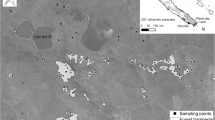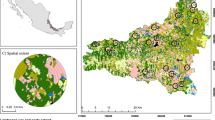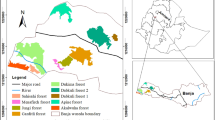Abstract
We examined vegetation structure and woody species diversity in relation to 14 environmental and anthropogenic factors in ten tropical dry forest (TDF) fragments in central Veracruz, Mexico. The basal area of the canopy (30.2 ± 2.11 m2/ha) and understory (1.96 ± 0.12 m2/ha) trees was similar, but density (1,014 ± 104 and 2,532 ± 227 individuals/ha, respectively) differed among sites. We recorded 98 canopy, 77 understory, and 60 seedling species. Richness was 24–45 species per site, Fisher’s alpha and Shannon’s indices increased with site altitude. Chao Jaccard indices revealed high species turnover, and a consistently higher similarity within the sites at the lowest and within the highest elevation sites. Ordination identified altitude, aspect, slope, water proximity, cattle and trails as significant explanatory variables of species patterns, and showed that sites at lower elevations were clearly separated from the other sites. Environmental heterogeneity alone did not control species diversity distribution, but species were affected by environmental filters at different stages in their life cycle, e.g., water proximity was significant for saplings and seedlings but not for adults. Anthropogenic disturbances act synergistically, e.g., trails played a key role in determining structure and tree diversity patterns. An important finding is that human disturbance diminishes species diversity in this TDF, but sites at lower elevations were more disturbed and less diverse, therefore we need to study how environmental factors would act if there were no anthropogenic disturbance.






Similar content being viewed by others
References
Angiosperm Phylogeny Group (2003) An update of the angiosperm phylogeny group classification for the orders and families of flowering plants: APG II. Bot J Linn Soc 141:399–436. doi:10.1046/j.1095-8339.2003.t01-1-00158.x
Balvanera P, Aguirre E (2006) Tree diversity, environmental heterogeneity, and productivity in a Mexican tropical dry forest. Biotropica 38:479–491. doi:10.1111/j.1744-7429.2006.00161.x
Balvanera P, Lott E, Segura G, Siebe C, Islas A (2002) Patterns of beta-diversity in a Mexican tropical dry forest. J Veg Sci 13:145–158
Bullock SH, Mooney HA, Medina E (1995) Seasonally dry tropical forests. Cambridge University Press, Cambridge
Castillo-Campos G, Davila-Aranda P, Zavala-Hurtado JA (2007) La selva baja caducifolia en una corriente de lava volcánica en el centro de Veracruz: lista florística de la flora vascular. Bol Soc Bot Mex 80:77–104
Challenger A (1998) Utilización y Conservación de los Ecosistemas Terrestres de México. Pasado, Presente y Futuro. Comisión Nacional para el Conocimiento y Uso de la Biodiversidad. UNAM, Agrupación Sierra Madre SC, México DF
Chao A, Chazdon RL, Colwell RK, Shen T-S (2005) A new statistical approach for assessing similarity of species composition with incidence and abundance data. Ecol Lett 8:148–159. doi:10.1111/j.1461-0248.2004.00707.x
Colwell RK (2005) EstimateS 7.5 user’s guide. http://purl.oclc.org/estimates or http://viceroy.eeb.uconn.edu/estimates
Durán E, Meave JA, Lott EJ, Segura G (2006) Structure and tree diversity patterns at the landscape level in a Mexican tropical deciduous forest. Bol Soc Bot Mex 79:43–60
Gallardo-Cruz JA, Meave JA, Pérez-García EA (2005) Estructura composición y diversidad de la selva baja caducifolia del Cerro Verde, Nizanda (Oaxaca), México. Bol Soc Bot Mex 76:19–35
Gallardo-López F, Riestra-Díaz D, Aluja-Schunemann A, Martínez Dávila JP (2002) Factores que determinan la diversidad agrícola y los propósitos de producción en los agroecosistemas del Municipio de Paso de Ovejas, Veracruz, México. Agrociencia 36:495–502
Gentry AH (1995) Diversity and floristic composition of neotropical dry forests. In: Bullock SH, Mooney HA, Medina E (eds) Seasonally dry tropical forests. Cambridge University Press, Cambridge, pp 146–194
Gillespie TW, Grijalva A, Farris CN (2000) Diversity, composition, and structure of tropical dry forests in Central America. Plant Ecol 147:37–47. doi:10.1023/A:1009848525399
Gordon JE, Newton AC (2006) The potential misapplication of rapid plant diversity assessment in tropical conservation. J Nat Conserv 14:117–126. doi:10.1016/j.jnc.2006.01.001
Gordon JE, Hawthorne WD, Reyes-García A, Sandoval G, Barrance AJ (2004) Assessing landscapes: a case study of tree and shrub diversity in the seasonally dry tropical forests of Oaxaca, Mexico and southern Honduras. Biol Conserv 117:429–442. doi:10.1016/j.biocon.2003.08.011
Jost L (2007) Partitioning diversity into independent alpha and beta components. Ecology 88:2427–2439. doi:10.1890/06-1736.1
Lott EJ, Bullock SH, Solís-Magallanes JA (1987) Floristic diversity and structure of upland and arroyo forests of coastal Jalisco. Biotropica 19:228–235. doi:10.2307/2388340
Magurran AE (2004) Measuring biological diversity. Blackwell, Oxford
McCune B (1997) Influence of noisy environmental data on canonical correspondence analysis. Ecology 78:2617–2623
McCune B (2007) Improved estimates of incident radiation and heat load using non-parametric regression against topographic variables. J Veg Sci 18:751–754
McCune B, Keon D (2002) Equations for potential annual direct incident radiation and heat load. J Veg Sci 13:603–606
Moody A, Meentemeyer RK (2001) Environmental factors influencing spatial patterns of shrub diversity in chaparral, Santa Yinez Mountains, California. J Veg Sci 12:41–52. doi:10.2307/3236672
Mooney HA, Bullock SH, Medina E (1995) Introduction. In: Bullock SH, Mooney HA, Medina E (eds) Seasonally dry tropical forests. Cambridge University Press, Cambridge, pp 1–8
Murphy PG, Lugo AE (1995) Dry forests of Central America and the Caribbean. In: Bullock SH, Mooney HA, Medina E (eds) Seasonally dry tropical forests. Cambridge University Press, Cambridge, pp 9–34
Mwaura F, Kaburu HM (2009) Spatial variability in woody species richness along altitudinal gradient in a lowland-dryland site, Lokapel Turkana, Kenya. Biodivers Conserv 18:19–32. doi:10.1007/s10531-008-9431-3
Pausas JG, Austin MP (2001) Patterns of plant species richness in relation to different environments: an appraisal. J Veg Sci 12:153–166. doi:10.2307/3236601
Poulos HM, Taylor AH, Beaty RM (2007) Environmental controls on dominance and diversity of woody plant species in a Madrean, Sky Island ecosystem, Arizona, USA. Plant Ecol 193:15–30. doi:10.1007/s11258-006-9245-x
ReForLan (2007) Restoration of forest landscapes for biodiversity conservation and rural development in the drylands of Latin America. http://reforlan.bournemouth.ac.uk/index.html
Rico-Gray V, García-Franco JG, Pouch A, Sima P (1988) Composition and structure of a tropical dry forest in Yucatán, México. Int J Ecol Environ Sci 14:21–29
Rzedowski J (1978) Vegetación de México. Editorial Limusa, México DF
Sabogal C (1992) Regeneration of tropical dry forests in Central America, with examples from Nicaragua. J Veg Sci 3:407–416. doi:10.2307/3235767
Sagar R, Singh JS (2006) Tree density, basal area and species diversity in a disturbed dry tropical forest of northern India: implications for conservation. Environ Conserv 33:256–262. doi:10.1017/S0376892906003237
SAS (1997) JMP user’s guide. SAS Institute, Cary
Segura G, Balvanera P, Durán E, Pérez A (2003) Tree community structure and stem mortality along a water availability gradient in a Mexican tropical dry forest. Plant Ecol 169:259–271. doi:10.1023/A:1026029122077
SEMARNAT 2002. Norma Oficial Mexicana NOM-059-ECOL-2001, Protección ambiental-Especies nativas de México de flora y fauna silvestres-Categorías de riesgo y especificaciones para su inclusión, exclusión o cambio—Lista de especies en riesgo. Diario Oficial de la Federación, México DF, 6 March 2002
ter Braak CJF, Smilauer P (1998) CANOCO reference manual and user’s guide to Canoco for Windows: software for canonical community ordination (version 4). Microcomputer Power. Centre for Biometry, Wageningen
Trejo I, Dirzo R (2000) Deforestation of seasonally dry tropical forest: a national and local analysis in Mexico. Biol Conserv 94:133–142. doi:10.1016/S0006-3207(99)00188-3
Trejo I, Dirzo R (2002) Floristic diversity of Mexican seasonally dry tropical forests. Biodivers Conserv 11:2048–2063. doi:10.1023/A:1020876316013
Trejo I, Hernández J, García-Guzmán G (2007) El impacto del cambio de uso del suelo en los bosques tropicales caducifolios en México. Paper presented at the XVII Mexican Congress of Botany, Zacatecas, 14–18 October 2007
Vargas-Rodríguez YL, Vázquez-García JA, Williamson GB (2005) Environmental correlates of tree and seedling-sapling distributions in a Mexican tropical dry forest. Plant Ecol 180:117–134. doi:10.1007/s11258-005-3026-9
Walton JC, Martínez-González F, Worthington R (2005) Desert vegetation and timing of solar radiation. J Arid Environ 60:697–707. doi:10.1016/j.jaridenv.2004.07.016
White DA, Hood CS (2004) Vegetation patterns and environmental gradients in tropical dry forests of the northern Yucatán Peninsula. J Veg Sci 15:151–160
Acknowledgments
We are grateful to María de Jesús Peralta for her valuable assistance in the field and herbarium, and to Daniela Trueba Nogueira and Luis Eduardo Zacarías for measurements and species identification in the initial stages of this project. We thank Fabiola López Barrera, Claudia Alvarez Aquino and an anonymous reviewer for their comments that improved the manuscript. This research was funded by the European Community under the INCO Project ReForLan (CT2006-032132).
Author information
Authors and Affiliations
Corresponding author
Additional information
Nomenclature Assignment of genera to families follows Angiosperm Phylogeny Group (2003).
Appendix
Appendix
Rights and permissions
About this article
Cite this article
Williams-Linera, G., Lorea, F. Tree species diversity driven by environmental and anthropogenic factors in tropical dry forest fragments of central Veracruz, Mexico. Biodivers Conserv 18, 3269–3293 (2009). https://doi.org/10.1007/s10531-009-9641-3
Received:
Accepted:
Published:
Issue Date:
DOI: https://doi.org/10.1007/s10531-009-9641-3




